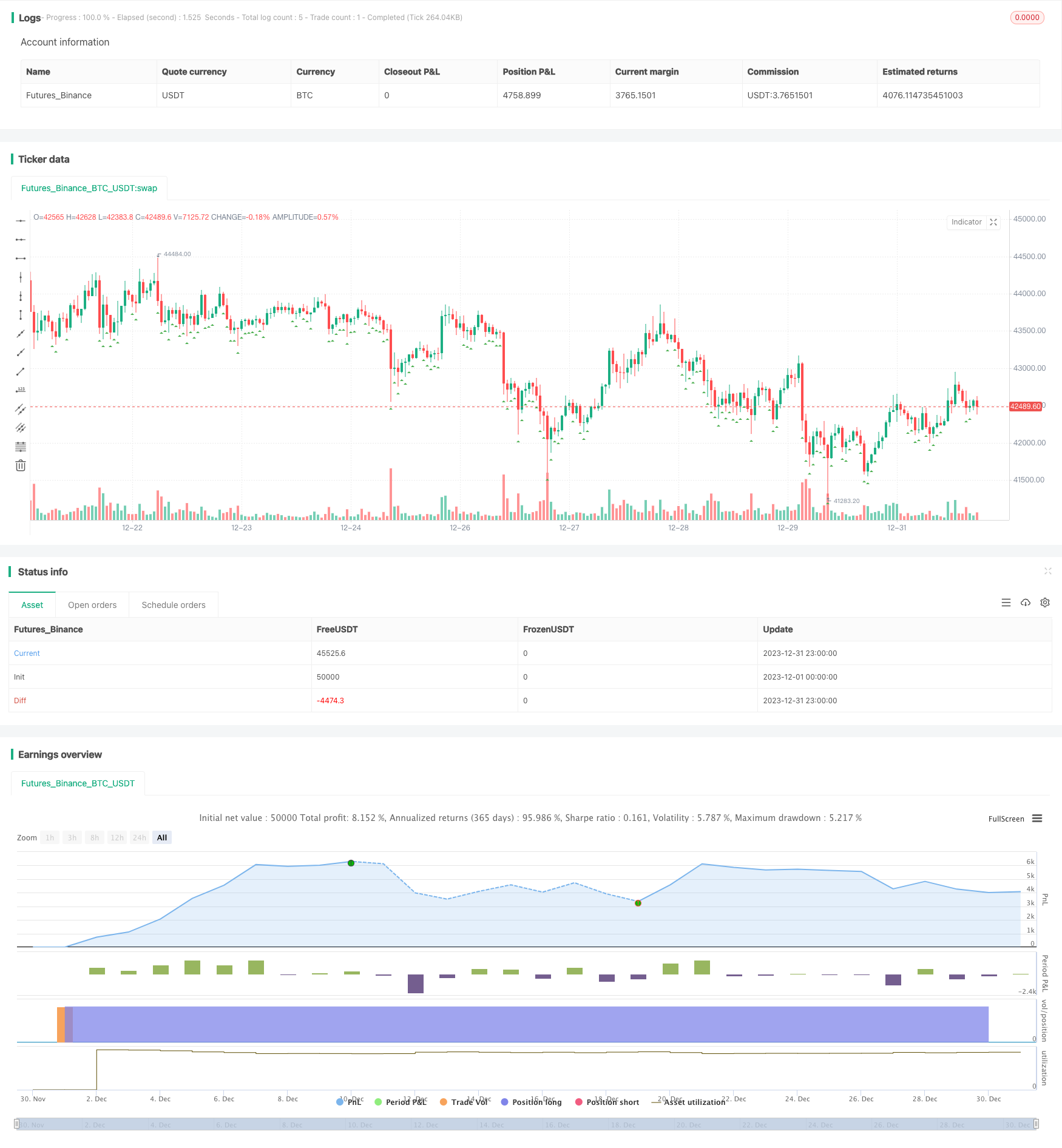
概述
RSI指标吸盘交易策略是一种集成了RSI和CCI技术指标的固定格子交易方法。该策略根据RSI和CCI指标的值来判断入场时机,采用固定盈利比例和固定格子数量来设置止盈单和加仓单。同时,策略还集成了对突破性价格变动的对冲机制。
策略原理
入场条件
当5分钟和30分钟RSI指标都低于设定阈值,而1小时CCI指标也低于设定值时,产生做多信号。此时记录当前close价格作为入场价格,并根据账户权益和格子数量计算出首单仓位。
停利条件
以入场价格为基准,按照设定的目标盈利比例计算出盈利价格,在该价格水平设置止盈单。
加仓条件
除首单外,其余的固定仓位加仓单会在入场信号后逐一放出,直到达到设定的格子数量。
对冲机制
如果价格较入场价格上涨超过设定的对冲阈值百分比,则对全部持仓进行对冲平仓。
反转机制
如果价格较入场价格下跌超过设定的反转阈值百分比,则取消所有未成交订单,等待新的入场机会。
优势分析
- 结合RSI和CCI两种指标提高获利概率
- 采用固定格子设定目标盈利,增加获利确定性
- 集成对冲机制,有效防范价格剧烈波动的风险
- 加入反转机制,可以减轻亏损
风险分析
- 指标产生错误信号的概率
- 价格剧烈波动突破对冲阈值
- 反转后再次调头无法重新入场
可以通过调整指标参数、扩大对冲幅度和减小反转幅度来降低这些风险。
优化方向
- 可以测试更多种类的指标组合
- 可以研究自适应止盈机制
- 可以优化加仓逻辑
总结
RSI指标吸盘交易策略通过指标判断入场时机,采用固定格子止盈和加仓来锁定稳定利润。同时,策略具备对冲大幅波动和反转后的重新入场机制。这种集成了多个机制的策略可以用于降低交易风险,提高获利率。通过进一步优化指标和参数设定,可以获得更好的实盘效果。
策略源码
/*backtest
start: 2023-12-01 00:00:00
end: 2023-12-31 23:59:59
period: 1h
basePeriod: 15m
exchanges: [{"eid":"Futures_Binance","currency":"BTC_USDT"}]
*/
//@version=5
strategy("Custom RSI/CCI Strategy with Fixed Grid", shorttitle="INVESTCOIN_RSI_CCI_Fixed_Grid", overlay=true)
// Input parameters
input_rsi_5min_value = 55
input_rsi_30min_value = 65
input_cci_1hr_value = 85
input_profit_target_percent = 0.6 // Target profit in percentage
input_grid_size = 15 // Number of orders in grid
input_hedging_percent = 20 // Percentage price change for hedging
input_first_order_offset = 0.2 // Offset for the first order in percentage
input_reversal_percent = 0.4 // Percentage price change for reversal
// Calculating the RSI and CCI values
rsi_5min = ta.rsi(close, 5)
rsi_30min = ta.rsi(close, 30)
cci_1hr = ta.cci(close, 60)
// Define strategy conditions based on the provided screenshot
long_condition = (rsi_5min < input_rsi_5min_value) and (rsi_30min < input_rsi_30min_value) and (cci_1hr < input_cci_1hr_value)
// Plot signals
plotshape(series=long_condition, title="Long Entry Signal", location=location.belowbar, color=color.green, style=shape.triangleup, size=size.small)
// Initialize a variable to store the entry price
var float entry_price = na
// Initialize a variable to store the profit target
var float profit_target = na
// Hedge condition based on price change percentage
var float hedge_price = na
// Initialize a variable to count the total number of orders
var int total_orders = 0
// Calculate the initial order size based on account equity and grid size
var float initial_order_size = 1 / input_grid_size / 100
// Entry orders with fixed size
if (long_condition and total_orders < 9000)
// Place first order with an offset
if total_orders == 0
strategy.order("First Long", strategy.long, qty=initial_order_size, limit=close * (1 - input_first_order_offset / 100))
total_orders := total_orders + 1
// Place remaining grid orders
for i = 1 to input_grid_size - 1
if (total_orders >= 9000)
break // Stop if max orders reached
strategy.entry("Long_" + str.tostring(i), strategy.long, qty=initial_order_size)
total_orders := total_orders + 1
// Calculate the profit target in currency
if (long_condition)
entry_price := close // Store the entry price when the condition is true
if (not na(entry_price))
profit_target := entry_price * input_profit_target_percent / 100 // Calculate the profit target
// Setting up the profit target
if (not na(profit_target))
strategy.exit("Take Profit", "Long", limit=entry_price + profit_target)
// Hedge by closing all positions if the price increases by the hedging percentage
if (strategy.position_size > 0)
hedge_price := close * (1 + input_hedging_percent / 100)
if (not na(hedge_price) and close >= hedge_price)
strategy.close_all(comment="Hedging")
// Reversal condition based on the price change percentage
var float reversal_price = na
if (strategy.position_size > 0 and total_orders > 1) // Check if at least one grid order has been placed
reversal_price := entry_price * (1 - input_reversal_percent / 100)
// Cancel trades and wait for a new entry point if the price reverses by the specified percentage
if (not na(reversal_price) and close <= reversal_price)
strategy.cancel_all()
total_orders := 0 // Reset the total orders count after cancellation